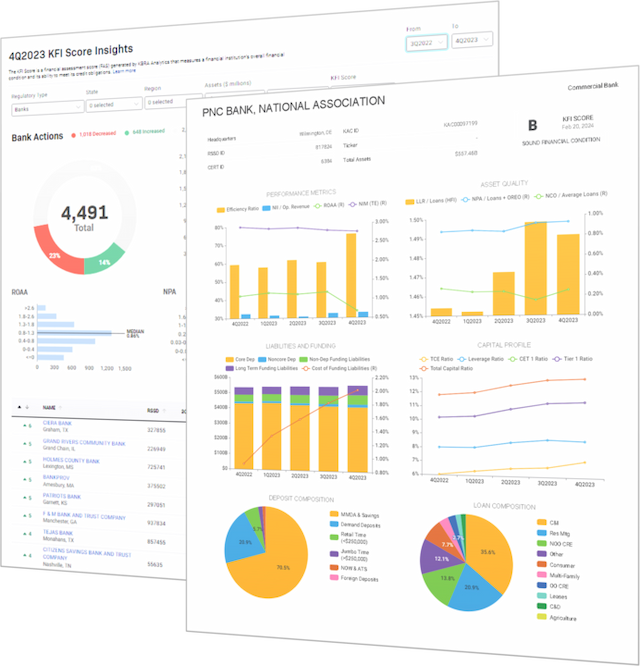KBRA Financial Intelligence
U.S. Election to Impact Bank Revenue From Credit Card and Service Fees
By KFI Staff
Both leading candidates in the upcoming U.S. presidential election—former President Donald Trump and current Vice President Kamala Harris—have expressed support for consumer protection policies that could affect significant revenue streams at U.S. banks.
In line with expanded capital requirements for large banks, the current administration has proposed measures to reduce consumer fees, such as overdraft charges. In 2022, the U.S. Consumer Financial Protection Bureau (CFPB) reported that the average overdraft fee was approximately $35. This figure has been referenced in policy discussions, with proponents of reform characterizing these charges as “surprise” fees. The CFPB has introduced a framework to cap overdraft fees at $14 for banks with more than $10 billion in assets, with public input sought on potentially reducing the cap further, possibly to $3. This change would impact revenue for the 115 U.S. banks above the $10 billion threshold that reported collecting overdraft fees in 2Q 2024. However, the proposed policy could be subject to revision based on future administration priorities. The CFPB Director’s term is scheduled to continue until October 2026, but changes in administration could impact agency leadership, in line with a 2020 Supreme Court decision granting the president authority to dismiss the CFPB director.
According to data from KFI, overdraft-related service charges generated nearly $2.8 billion in 1Q 2020, representing around 2.1% of total revenue among banks reporting such fees. This figure may be understated, as only banks with assets exceeding $1 billion are required to disclose noninterest income from service charges on deposit accounts.

Even without new overdraft regulations in place, several large U.S. banks have already willingly eliminated or reduced overdraft fees. Major banking industry names such as Ally Bank (KFI Score: B), Capital One, N.A. (KFI Score: C+), and Citibank, N.A. (KFI Score: B) have ended the practice of charging these service fees outright, while Bank of Montreal, N.A. (KFI Score: B) cut its overdraft fee in half in 2022. The annual sum of revenue earned from overdraft fees declined sequentially across each year from 2020-2023, falling to $5.6 billion from $11.3 billion throughout the period. Based on 1H 2024, this year is on track to see annual overdraft fees decline once again. However, some institutions have remained resistant to winding down their overdraft programs—either to compete for small deposit accounts that may be susceptible to overdrafting or in anticipation of a legislative crackdown. For example, Woodforest National Bank (KFI Score: B) collected 15% of its 2Q 2024 revenue in the form of overdraft-related fees, leading all U.S. banks in this metric. Woodforest currently charges $32 each time an account is overdrafted by more than $1, but the bank would be exempt from the proposed CFPB overdraft rule, as it only carried total assets of $9.3 billion in 2Q 2024. If the bank continues to grow and surpasses $10 billion in assets, it could potentially become subject to lower benchmark fees in the future.

Both leading presidential candidates have introduced proposals that could impact banks’ credit card revenue. Alongside ongoing efforts to reduce overdraft fees, the candidates have also suggested adjustments to fees related to late payments on credit card balances. In March 2024, the U.S. CFPB finalized a rule to lower the average late fee to $8 from $32, which is projected to save consumers an estimated $10 billion per year. However, this rule has been temporarily blocked following a preliminary injunction granted by a U.S. district judge in May in response to a lawsuit led by the U.S. Chamber of Commerce. As a result, the rule’s implementation is on hold pending further judicial review, leaving open the possibility of revisions under a future CFPB leadership.
A proposal from the Trump campaign would establish a temporary cap on credit card APRs at 10%, below the current 21.8% average rate, aiming to provide debt relief for consumers in light of recent inflation trends. This initiative addresses the substantial increase in outstanding credit card debt, which has risen by over 25% (or $330 billion) since early 2021. Earlier this month, KFI noted that U.S. credit card debt and revolving plans surpassed $1.07 trillion, continuing to grow at a 5.4% year-over-year rate as of last month. Since hitting a low point in 3Q 2021, credit card delinquencies have more than doubled, reaching a 12-year high of 3.3% and outpacing increases in other loan categories. Additional insights, including delinquency rates across various loan types by individual banks and credit unions, are available through KFI’s Loan Category and Delinquency Report template in the Template Library.

Implementing a cap on credit card APRs could reduce interest expenses for consumers with carried balances, although it may also restrict access to revolving credit for a significant portion of Americans. In response to reduced profitability under a 10% cap, credit card issuers might limit new card offerings, especially to borrowers with higher credit risk, whose repayment challenges may exceed what that rate of interest can cover. Although proposed by Trump’s campaign, support for credit card rate caps has appeared across the political spectrum, with lawmakers from both parties introducing related legislation. The Empowering States’ Rights to Protect Consumers Act of 2023, backed by Senators Elizabeth Warren (D-MA) and Bernie Sanders (I-VT), seeks to amend the 1968 Truth in Lending Act to grant states the authority to set maximum APRs for consumer credit transactions. As with the administration’s late fee proposals, any move to mandate credit card rate caps would likely prompt legal challenges from the banking sector. In a recent report, Bank Earnings Flag Potential Wave of Credit Losses, Loan Loss Reserves Jump to Three-Year High, KFI identified a group of banks with significant exposure to credit card lending and assessed their potential vulnerability to rising credit losses.
